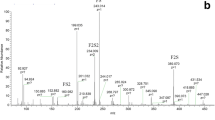Abstract
A high molecular weight sulphated (18.4%) proteoglycan was isolated from extracts of Codium fragile ssp. atlanticum by molecular exclusion chromatography on Sepharose 2B. Ion exchange chromatography, using Sepharose CL-6B, of lower molecular weight components eluted from the Sepharose 2B column gave two major products with sulphate contents of 10.2% and 7.5%, respectively. Anticoagulant activities of each of the three products were assessed using coagulation techniques and chromogenic substrate assays. An increase in anticoagulant effect was demonstrated by increasing concentration and sulphate content of each algal component. The mechanism of anticoagulant action was shown to be, principally, anti-thrombin in character due to potentiation of heparin cofactor II and antithrombin III activity. Although the anticoagulant substances described are unlikely to be used as antithrombotic therapeutic agents, they have uses as biomedical reagents for investigation of the processes of thrombin inhibition.
Similar content being viewed by others
References
Anderson W, Duncan JGC (1965) The anticoagulant activity of carrageenan. J Pharm. Pharmacol. 17: 647–654.
Atha DH, Stephens AW, Rosenberg RD (1984) Evaluation of critical groups required for the binding of heparin to antithrombin. Proc. natl. Acad. Sci. 81: 1030–1034.
Brozovic M (1991) Investigation of acute haemostatic failure. In Dacie JV, Lewis SM (eds), Practical Haematology. Churchill Livingstone, Edinburgh 279–292.
Cambell A, Nesheim ME, Doctor VM (1987) Mechanism of potentiation of antithrombin III (ATIII) inhibition of sulfated xylans. Thromb. Res. 47: 341–352.
Chargaff E, Bancroft FW, Stanley-Brown M (1936) Studies on the chemistry of blood coagulation II. On the inhibition of blood clotting by substances of high molecular weight. J. biol. Chem. 115: 155–161.
Church FC, Meade JB, Treanor RE, Whinna HC (1989) Antithrombin activity of fucoidan. J. biol. Chem. 264: 3618–3623.
Deacon-Smith RA, Lee-Potter J, Rogers DJ (1985) Anticoagulant activity in extracts of British marine algae. Bot. mar. 28: 333–338.
Dubois MK, Gilles KA, Hamilton JK, Rebers PA, Smith F (1956) Colourimetric method for determination of sugars and related substances. Analyt. Chem. 28: 350–356.
Fenton II JW, Olson TA, Zabinski MP, Wilner GD (1988) Anion-binding exosite of human α-thrombin and fibrin(ogen) recognition. Biochemistry 27: 7106–7112.
Grauffel V, Kloareg B, Mabeau S, Durand P, Jozefonvicz J (1989) New natural polysaccharides with potent antithrombic activity: fucans from brown algae. Biomaterials 10: 363–368.
Hurst RE, Poon M-C (1983) Structure-activity relationships of heparin. Independence of heparin charge density and antithrombin-binding domains in thrombin inhibition of antithrombin and heparin cofactor II. J. clin. Invest. 72: 1042–1045.
Kindness G, Williamson FB, Long WF (1980) Involvement of antithrombin III in anticoagulant effects of sulphated polysaccharides. Biochem. Soc. Trans. 8: 82–83.
Maimone MM, Tollefsen DM (1990) Structure of a dermatan sulphate hexasaccharide that binds to heparin cofactor II with high affinity. J. biol. Chem. 265: 18263–18271.
McLellan DS, Jurd KM (1991) Anticoagulants from marine algae. Blood Coagulation and Fibrinolysis 3: 69–77.
Millar GL (1959) Protein determinations for a large number of samples. Analyt. Biochem. 31: 964.
Oshima G (1989) The molecular-mass dependence of dextran sulphate enhancement of inactivation of thrombin and fibrinogen and on factor Xa neutralization by antithrombin III. Biol. Chem. 370: 715–721.
Rogers DJ, Jurd KM, Blunden G, Paoletti S, Zanetti F (1990) Anticoagulant activity of a proteoglycan in extracts of Codium fragile ssp. atlanticum. J. appl. Phycol. 2: 357–361.
Scully MF, Kakkar VV (1984) Effect of pentosan polysulphate upon thrombin and factor Xa inactivation by antithrombin III. Biochem. J. 222: 571–578.
Silvestri LJ, Hurst RE, Simpson L, Settine JM (1982) Analysis of sulphate in complex carbohydrates. Analyt. Biochem. 123: 303–309.
Walton KW (1954) Investigation of the toxicity of a series of dextran sulphates of varying molecular weight. Br. J. Pharmacol. 9: 1–14.
Author information
Authors and Affiliations
Rights and permissions
About this article
Cite this article
Jurd, K.M., Rogers, D.J., Blunden, G. et al. Anticoagulant properties of sulphated polysaccharides and a proteoglycan from Codium fragile ssp. atlanticum . J Appl Phycol 7, 339–345 (1995). https://doi.org/10.1007/BF00003790
Received:
Revised:
Accepted:
Issue Date:
DOI: https://doi.org/10.1007/BF00003790



